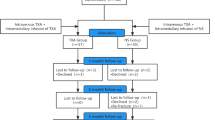Abstract
Introduction
In corrective osteotomy, wound closure is undertaken with or without deflation of the tourniquet. Hypoxia from the tourniquet causes vasodilatation associated with reactionary haemorrhage and reduced haemoglobin concentration and possibly increased blood transfusion rate. Reactionary haemorrhage and related transfusion need can be reduced through vasoconstriction from adrenaline infiltration.
Method
A randomized, placebo-controlled trial was done to compare adrenaline–saline solution to normal saline in the control of reactionary haemorrhage after proximal tibial osteotomy in children. Sixty-one eligible patients were divided into two groups and had corrective osteotomy under the same surgeon over a period of 7 years.
Results
Wound infiltration with adrenaline–saline solution 1:200,000 and normal saline was done in groups one and two, respectively. No intra-operative adverse effect was recorded. There was a 20% incidence of superficial wound dehiscence in group 1 and none in controls. The mean volume of blood in drains in the first 24 h post operation was 85 ml in group 1 and 225 ml in group 2 (p < 0.001). The mean haemoglobin level on the fifth day post operation was 11.8 g/dl in group 1 and 8.2 g/dl in group 2 (p < 0.001). There was no blood transfusion in group one while two patients were transfused in group two.
Conclusion
In conclusion, wound infiltration with adrenaline was effective in reducing the extent of reactionary haemorrhage and post-operative drop in haemoglobin concentration. There was no significant difference in the transfusion rates in both groups.
Similar content being viewed by others
References
Shiga T, Wajima Z, Inoue T, Sakamoto A (2005) Aprotinin in major orthopedic surgery: a systematic review of randomized controlled trials. Anesth Analg 101:1602–1607
Lauder GR (2007) Pre-operative predeposit autologous donation in children presenting for elective surgery: a review. Transfus Med 17:75–82
Dunn CJ, Goa KL (1999) Tranexamic acid: a review of its use in surgery and other indications. Drugs 57:1005–1032
Lehmann M, Hasler K, Bergdolt E, Keul J (1986) Alpha-2-adrenoreceptor density on intact platelets and adrenaline-induced platelet aggregation in endurance- and nonendurance-trained subjects. Int J Sports Med 7:172–176
Yun-Choi HS, Park KM, Pyo MK (2000) Epinephrine induced platelet aggregation in rat platelet-rich plasma. Thromb Res 100:511–518
Thomas SS, Srivastava S, Nancarrow JD, Mohmand MH (1999) Dilute adrenaline infiltration and reduced blood loss in reduction mammaplasty. Ann Plast Surg 43:127–131
Oxner RB, Simmonds NJ, Gertner DJ, Nightingale JM, Burnham WR (1992) Controlled trial of endoscopic injection treatment for bleeding from peptic ulcers with visible vessels. Lancet 339(8799):966–968
Morris T, Appleby R (2005) Retardation of wound healing by procaine. Br J Surg 67:391–392
Ogbemudia AO, Bafor A, Edomwonyi E, Ogbemudia PE (2008) Sterile pneumatic tourniquet adapted from the aneroid sphygmomanometer: technique and results. Niger J Ortho Trauma 7:45–47
Gasparini G, Papaleo P, Pola P, Cerciello S, Pola E, Fabbriciani C (2006) Local infusion of norepinephrine reduces blood losses and need of transfusion in total knee arthroplasty. Int Orthop 30:253–256
Tsumara N, Yoshiya S, Chin T, Shiba R, Kohso K, Doita M (2006) A prospective comparison of clamping the drain or post-operative salvage of blood in reducing blood loss after total knee arthroplasty. J Bone Joint Surg [Br] 88:49–53
Mesa-Ramos F, Mesa-Ramos M, Maquieira-Canosa C, Carpintero P (2008) Predictors for blood transfusion following total knee arthroplasty: a prospective randomised study. Acta Orthop Belg 74(1):83–89
Padala PR, Rouholamin E, Mehta RL (2004) The role of drains and tourniquets in primary total knee replacement: a comparative study of TKR performed with drains and tourniquet versus no drains and adrenaline and saline infiltration. J Knee Surg 17(1):24–27
Gasparini G, Papaleo P, Pola P, Cerciello S, Pola E, Fabbriciani C (2006) Local infusion of norepinephrine reduces blood losses and need of transfusion in total knee arthroplasty. Int Orthop 30(4):253–256
Braithwaite BD, Robinson GJ, Burge PD (1993) Haemostasis during carpal tunnel release under local anaesthesia: a controlled comparison of a tourniquet and adrenaline infiltration. J Hand Surg Br 18:184–186
Author information
Authors and Affiliations
Corresponding author
Rights and permissions
About this article
Cite this article
Ogbemudia, A.O., Bafor, A. & West-Osemwengie, L. Reactionary haemorrhage reduction with adrenaline infiltration in proximal tibial osteotomy: a randomized clinical study of safety and efficacy. Arch Orthop Trauma Surg 132, 21–24 (2012). https://doi.org/10.1007/s00402-011-1389-z
Received:
Published:
Issue Date:
DOI: https://doi.org/10.1007/s00402-011-1389-z




